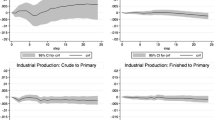Abstract
The transition from N. D. Kondratiev’s concept of long business cycles to an endogenous model of long waves is depicted. The features of long-term trends in the development of the world economy in the 21st century are analyzed. They are associated with the exacerbation of competition from major developing countries, changes in the balance of forces between the advanced economies and the rest of the world, and their impact on the pace of the world economy development. The role of information and communication technologies in the formation of the ascending wave at the beginning of the 21st century is assessed. Prospects of solving the problem of employment of the economically active population are evaluated.
Similar content being viewed by others
References
N. D. Kondratiev, Problems of Economic Dynamics (Economica, Moscow, 1989).
V. G. Klinov, Long Business Cycles in the World Economy. Problems of Analysis and Forecasting (VNIIPI, Moscow, 1992).
N. D. Kondratiev, Long Business Cycles and the Theory of Foresight (Economica, Moscow, 2002).
V. G. Klinov, Forecasting of Long-Term Trends in the World Economy (Magistr, Moscow, 2010).
A. Maddison, The World Economy Historical Statistics (OECD, Paris, 2003).
E. F. Denison, Measurement of Labor Input. Output, Input and Productivity Measurement (Princeton University Press, Princeton, 1961).
Economic Report of the President (USGPO, Washington, 2014).
A. Maddison, Phases of Capitalist Development (Oxford University Press, Oxford, 1982).
World Development Indicators, 2014, http://databank.worldbank.org/data/views/reports/tableview.aspx
National Accounts of OECD Countries (OECD, Paris, 1970–2014).
V. G. Klinov, Business Conditions. Factors and Mechanisms of Formation (Economica, Moscow, 2005).
Bureau of Economic Analysis, 2014, http://www.bea.gov/itable/
Economic Report of the President (USGPO, Washington, 2000).
World Economy at the Beginning of the 21st Century (Direct-Media, Moscow, 2013).
R. Harding, “Technology shakes up US economy,” Financial Times (2014, March 26).
V. G. Klinov, Actual Problems of the Study of Business Conditions (Magistr, Moscow, 2013).
Tax Reforms in EU Member States 2014, Brussels, European Commission.
“Tax reform,” The Economist (London, 2014, Jul 13th).
“Obama proposes deal over taxes and jobs,” NY Times (2014, July 30).
Author information
Authors and Affiliations
Corresponding author
Additional information
Original Russian Text © V.G. Klinov, 2015.
The article is based on the results of the research carried out under a grant of the Russian Humanitarian Science Foundation (project no. 14-02-00330).
The article was translated by the author.
Rights and permissions
About this article
Cite this article
Klinov, V.G. The evolution of long waves in the world economy. Stud. Russ. Econ. Dev. 26, 285–294 (2015). https://doi.org/10.1134/S1075700715030077
Received:
Published:
Issue Date:
DOI: https://doi.org/10.1134/S1075700715030077




